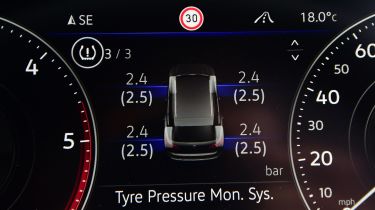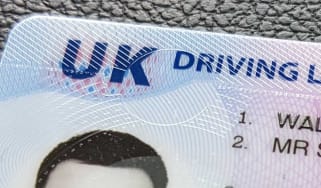What is a TPMS? Tyre pressure monitoring systems explained
Tyre pressure is crucial to the performance, efficiency and safety of your car and the best way of making sure they’re always as they should be is with a TPMS

Tyres are one of, if not the most important part of your car. They’re your connection to the road, and if they’re not on top form your car won’t grip effectively, nor will it be as efficient as it could be - needlessly costing you money.
Tyre pressure monitoring systems (TPMS) show you how much pressure is in your tyres, letting you know if you need to give them a quick top up to keep your car on top form. They’ve been fitted to all new cars as standard since 2014, though you can buy aftermarket kits for older models and the systems can be invaluable both in preventing accidents and saving pennies at the pumps.
What is a TPMS?
A TPMS is a system of sensors that constantly check how much air pressure is inside your tyre. If the sensor on one tyre detects levels have dropped below a certain level, they’ll let you know you’re running low.
How do they work?
There are two types of TPMS. The first is ‘direct’. Fitted to a car’s tyre valve, they measure how much pressure is in the tyre and feed it back to your car’s internal computer. If it detects your pressure is below a set level, it’ll alert you via the dashboard or infotainment screen and prompt you to top up.
Depending on how advanced the direct system is, you might be told which tyre needs attention and how much air is needed, or you’ll simply be told that one of your tyres needs checking, which is your cue to head to a petrol station (or foot pump) as soon as possible to find which one is low.
The second type of sensor is ‘indirect.’ These don't measure pressure itself, but instead use a car’s wheel speed sensors. A wheel moving faster and turning more than it should is likely to be low on tyre pressure, and should be looked at. The indirect systems are less accurate because they don’t measure pressure itself, rather doing sums on how fast a wheel should be spinning. If you’ve fitted different tyres on different wheels of your car, they may register a false drop in pressure, too.
What do I do if the TPMS sensor tells me my tyre pressures are low?
If your TPMS lets you know you need air in one or more of your tyres you have one course of action: top up as soon as possible. If the car is safe to move - driving with a completely flat tyre is dangerous and can cause an accident as well as damage to your car - you can head to a petrol station to use an air pump. Alternatively you can use a foot or tyre inflator pump at home if you have one. Cars with tyre puncture repair kits instead of spare wheels in the boot often have an electric tyre inflator in the boot. If your car is not safe to drive, call your breakdown service and wait for help.
How do I know what my tyre pressures should be?
Depending on your car, the correct tyre pressures may be on a sticker on the frame inside the driver or passenger’s door. Failing that, you should be able to find them in your car’s manual. If you come up empty on both of those, Google is your friend.
What if my car doesn’t have a TPMS?
While most new cars sold after 2014 have them fitted as standard, many older cars don’t have a TPMS. Fear not, as there are plenty of options out there on the aftermarket. We tested the best, so you don’t have to guess which will do the job.
Frequently Asked Questions
The TPMS light will illuminate on the car’s dashboard when one or more of your tyres fall below a certain pressure. More modern systems will give you the current pressures of all your tyres on the infotainment system so you can see how low the pressures actually are. Generally, it will be safe to drive when the TMPS light first comes on but the best advice is to quickly check the tyres and head to a garage to inflate them. The light coming on could be an indication of a gradual reduction in pressure over time, a sensor fault or a more serious puncture. Do not drive on a significantly deflated tyre.
Tired tyres? These are the best car tyres to buy now...
Find a car with the experts







